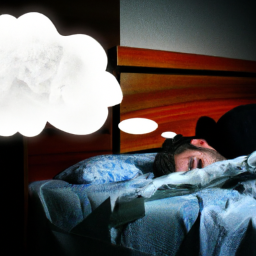Were you aware that 75% of frequent marijuana users report having vivid dreams once they stop using the substance?
As someone who recently quit smoking weed, I can attest to the intensity of these dreams. While some people may find them enjoyable, others can find them overwhelming and disruptive to their sleep patterns.
In this article, I will explore the science behind dreaming and how quitting weed can affect our dreams. I will also discuss common themes in vivid dreams after quitting, how long they can last, and tips for managing them.
For many people, quitting weed can lead to a surge in dream activity. This is because marijuana use can suppress REM sleep, the stage of sleep where we experience the most vivid dreams. When we stop using marijuana, our brain tries to catch up on the REM sleep it missed, leading to an increase in dream frequency and intensity.
While this can be a positive thing for some, it can also be overwhelming for others. Personally, I found that my vivid dreams were often disturbing and left me feeling tired and anxious in the morning.
If you are experiencing vivid dreams after quitting weed, know that you are not alone and there are ways to manage them.
Key Takeaways
- Quitting weed can lead to a surge in dream activity as the brain tries to catch up on the REM sleep it missed.
- Vivid dreams after quitting typically last for a few weeks.
- The increase in vivid dreams is temporary and should subside within a few weeks.
- Lack of sleep can exacerbate vivid dreams, so it’s important to prioritize getting enough rest.
The Science of Dreaming and Sleep Patterns
You might be surprised to learn that during the rapid eye movement (REM) stage of sleep, when your most vivid dreams occur, your brain is actually more active than when you’re awake.
This is because during REM sleep, the brain is processing and consolidating information from the day, making connections between memories, and generating new ideas and insights. It’s also the time when the brain is most active in terms of emotion regulation, which is why dreams can be so intense and emotionally charged.
This increased brain activity during REM sleep is also the reason why quitting weed can lead to more vivid dreams. THC, the active ingredient in marijuana, actually suppresses REM sleep, which means that when you stop using it, your brain rebounds and goes into overdrive during this stage of sleep.
So, while you may not remember your dreams when you smoke regularly, quitting can lead to a flood of intense, vivid dreams as your brain tries to catch up on the REM sleep it missed.
Why Quitting Weed Leads to More Vivid Dreams
When someone stops using marijuana, their brain chemistry begins to shift, which can lead to a surge in the intensity and frequency of their nighttime imaginings. This happens because THC, the active ingredient in marijuana, suppresses REM sleep, which is the stage of sleep when we dream the most vividly.
When the brain adjusts to the absence of THC, it compensates for the missed REM sleep by increasing the duration and intensity of dreams. This phenomenon is known as the REM rebound effect. The REM rebound effect can be unsettling for some people, especially if they were long-term marijuana users.
The vivid dreams can feel so real that they may confuse them with reality, leading to anxiety and other negative emotions. However, the REM rebound effect is usually temporary and subsides after a few weeks or months.
In the next section, we will explore some of the common themes that people report experiencing in their vivid dreams after quitting marijuana.
Common Themes in Vivid Dreams After Quitting
I’ve had some pretty intense dreams since I quit smoking weed, and I’m not alone.
After doing some research, I found that there are a few common themes that tend to show up in these vivid dreams. One of the biggest factors seems to be anxiety and stress, which can manifest in all sorts of strange ways in our dreams.
Another key theme is emotional processing, as we work through unresolved issues and feelings from our waking lives.
And for those who are really lucky, there’s the possibility of experiencing lucid dreaming, where you can consciously control and manipulate the dream world.
Anxiety and Stress
Experiencing anxiety and stress can prolong the duration of vivid dreams after quitting weed. I noticed this firsthand when I decided to stop smoking and experienced a surge of anxiety and stress.
My dreams became more intense, and I found myself waking up multiple times during the night. It was as if my mind was working overtime to process all the emotions and thoughts that I had suppressed while smoking.
This prolonged duration of vivid dreams can be frustrating and exhausting, but it can also be a sign of progress in emotional processing. As I continued to face my anxiety and stress head-on, I noticed that my dreams became less intense and more manageable.
It was as if my mind was finally processing the emotions that I had been numbing with weed.
Emotional Processing
You may feel like you’re on an emotional rollercoaster after quitting weed, but it’s important to take the time to process your feelings and work through any unresolved issues. This process of emotional processing can be challenging, but it’s necessary to move forward and heal.
Try to identify and acknowledge your emotions, without judging or suppressing them. This can involve talking to a therapist or trusted friend, journaling, or practicing mindfulness.
As you work through your emotions, you may start to notice changes in your dreams. Vivid dreams are common after quitting weed, and they can be a reflection of your emotional state. While it may be unsettling to experience intense dreams, they can also offer insight into your subconscious mind.
In the next section, we’ll discuss the phenomenon of lucid dreaming and how it relates to quitting weed.
Lucid Dreaming
Get ready to take control of your dreams with the fascinating phenomenon of lucid dreaming and its connection to quitting weed. As someone who’s personally experienced this, I can attest that quitting weed can lead to more vivid and memorable dreams, which can then lead to the possibility of lucid dreaming.
Here are some interesting points to keep in mind:
-
Lucid dreaming is the ability to become aware that you’re dreaming while you’re still in the dream. This allows you to take control of the dream and do things that you may not be able to do in real life.
-
Quitting weed can increase the chances of lucid dreaming because it allows for more REM (rapid eye movement) sleep, which is the stage of sleep where most dreaming occurs.
-
To increase your chances of having a lucid dream, try practicing reality checks throughout the day. This involves questioning whether or not you’re dreaming and looking for signs that you are (such as being able to breathe underwater). This habit will carry over into your dreams and increase your chances of becoming lucid.
With the potential for lucid dreaming after quitting weed, it’s no wonder that many people are curious about how long vivid dreams last after quitting.
How Long Do Vivid Dreams Last After Quitting?
The duration of vivid dreams after quitting weed varies from person to person, but they typically last for a few weeks. Personally, I experienced vivid dreams for about two to three weeks after quitting.
At first, it was exciting to have such vivid dreams that felt so real, but after a few nights, it became exhausting. I would wake up feeling like I had just finished a marathon.
However, there are ways to manage these vivid dreams. Tips for managing vivid dreams include practicing relaxation techniques before bed, avoiding caffeine and alcohol, and creating a calming bedtime routine.
By implementing these tips, I was able to minimize the impact of my vivid dreams and get better sleep overall.
Tips for Managing Vivid Dreams
Now that we know how long vivid dreams can last after quitting weed, let’s talk about some tips for managing them. I personally experienced very vivid dreams for several weeks after quitting, and while they can be enjoyable at times, they can also be overwhelming and disruptive to sleep.
Here are some things that helped me cope:
- Establish a relaxing bedtime routine
- Practice deep breathing or meditation before bed
- Avoid caffeine and large meals before bed
- Keep a dream journal to help process any intense or confusing dreams
- Talk to a therapist or support group about any emotional or psychological effects of quitting
These tips may not completely eliminate vivid dreams, but they can make them more manageable and less disruptive to daily life. Now, let’s delve into the connection between weed and dreams.
The Connection Between Weed and Dreams
While many people may associate smoking weed with a good night’s sleep, the truth is that the drug can actually have a significant impact on the content and quality of one’s dreams. Marijuana use can suppress REM (Rapid Eye Movement) sleep, which is the stage of sleep where most of our dreaming occurs. This means that when someone quits smoking weed, they may experience an increase in vivid dreams and nightmares, as their brain makes up for lost REM sleep.
It’s important to note that not everyone who quit smoking weed will experience an increase in vivid dreams. However, for those who do, it can be helpful to understand the connection between weed and dreams. The following table summarizes the main points:
| Weed and Dreams |
|---|
| Marijuana use can suppress REM sleep |
| Quitting weed can lead to an increase in vivid dreams and nightmares |
| Not everyone who quits weed will experience this effect |
| The increase in vivid dreams is temporary and should subside within a few weeks |
| Practicing good sleep hygiene can help alleviate the intensity of vivid dreams |
As we can see from the table, the increase in vivid dreams is temporary and should subside within a few weeks. However, quitting marijuana can have other effects on the body and mind, which we will explore in the next section.
Other Effects of Quitting Marijuana
Quitting marijuana can have a range of effects on the body and mind, from changes in appetite and mood to difficulty sleeping and increased anxiety. In addition to these common symptoms, there are other effects that you may experience after quitting. These include:
- Irritability and mood swings
- Headaches
- Sweating and chills
These symptoms can vary in intensity and duration depending on the individual. It’s important to note that these effects are temporary and will eventually subside as your body adjusts to the absence of marijuana.
If you’re experiencing any of these symptoms, it’s important to take care of yourself and find alternative methods for managing them. This can include practicing relaxation techniques such as meditation or yoga, engaging in regular exercise, and seeking support from friends and family. By taking care of your body and mind, you can make the transition to a marijuana-free lifestyle a smoother and more positive experience.
Alternative Methods for Managing Symptoms
I’ve found that quitting marijuana can be tough, especially when it comes to managing the symptoms.
Luckily, there are alternative methods that can help. Three effective options are CBD products, therapy and counseling, and making lifestyle changes.
These methods have helped me cope with the symptoms of quitting and I hope they can help others too.
CBD Products
CBD products can help take the edge off and lead to a more restful night’s sleep, giving you the chance to ‘catch some Z’s’. These products are derived from the cannabis plant, but don’t contain the psychoactive compound THC, which is responsible for the ‘high’ associated with marijuana use. Instead, CBD products have a calming effect on the body and mind, making them a popular choice for those struggling with anxiety, pain, and insomnia.
While CBD products may provide some relief for those experiencing vivid dreams after quitting weed, they may not be a complete solution. It’s important to consider other forms of therapy and counseling that can address the root causes of these symptoms. Seeking professional help can provide a safe and supportive environment to explore and process any underlying emotions or psychological issues that may be contributing to the vivid dreams.
Therapy and Counseling
You can benefit greatly from seeking therapy or counseling if you’re struggling with the emotional toll of vivid dreams. These dreams can be intense and overwhelming, often leaving you feeling drained and anxious. Talking to a therapist can help you process these emotions and develop coping mechanisms to deal with them. They can also help you identify any underlying issues that may be contributing to your vivid dreams, such as anxiety or trauma.
In addition to therapy, there are also lifestyle changes you can make to help manage vivid dreams. One of the most important is getting enough sleep. Lack of sleep can exacerbate vivid dreams, so it’s important to establish a consistent sleep schedule and prioritize getting enough rest.
Other lifestyle changes that may help include reducing stress, exercising regularly, and avoiding drugs and alcohol. By making these changes and seeking support from a therapist, you can begin to manage the emotional toll of vivid dreams and work towards a better night’s sleep.
Lifestyle Changes
While therapy and counseling can be very helpful for managing the emotional side effects of quitting weed, there are also some lifestyle changes that can make a big difference. For me, one of the most important changes was creating a consistent sleep routine.
When I was smoking weed regularly, I often stayed up late and had trouble falling asleep without it. But now that I’ve quit, I’ve made it a priority to go to bed and wake up at the same time every day, even on weekends. This has helped me fall asleep more easily and wake up feeling more rested.
Another change that has helped me cope with the vivid dreams that come with quitting weed is getting regular exercise. I’ve found that going for a run or doing yoga in the morning helps me feel more grounded and centered throughout the day. It also seems to help me sleep more deeply at night, which can make the dreams feel less intense.
Of course, everyone’s experience is different, but I’ve found that these lifestyle changes have made a big difference for me.
While therapy and lifestyle changes can be incredibly helpful for managing the effects of quitting weed, it’s also important to seek support from others. Whether it’s talking to a friend who has been through a similar experience or joining a support group, having a community of people who understand what you’re going through can make a big difference.
In the next section, we’ll talk more about the importance of seeking support and how it can help you stay on track with your goals.
The Importance of Seeking Support
Don’t underestimate the value of seeking support when dealing with the duration of vivid dreams after quitting weed. It’s common to feel alone and overwhelmed during this time, but having someone to talk to can make a big difference.
This could be a friend, family member, therapist, or support group. Talking to someone about your experiences can provide validation and comfort. It can also help you process your emotions and gain perspective.
Additionally, support can help you stay motivated and accountable for staying sober. Don’t be afraid to reach out for help, as it can be a crucial part of your recovery journey.
Frequently Asked Questions
What are some potential negative effects of not having vivid dreams after quitting weed?
Not having vivid dreams after quitting weed may lead to a lack of dream recall or a decrease in creativity and problem-solving abilities. It is important to work on improving dream recall through techniques such as journaling and visualization.
Can vivid dreams after quitting weed be a sign of a more serious underlying condition?
I was worried when I started having intense, vivid dreams after quitting weed. But after consulting with my doctor, I found out that it’s actually a common occurrence and not a sign of a serious underlying condition.
Are there any natural remedies that can help alleviate vivid dreams after quitting weed?
There are natural remedies that can help alleviate vivid dreams after quitting weed, such as practicing relaxation techniques, exercising regularly, and avoiding caffeine and alcohol before bed.
How long does it take for the body to completely detox from marijuana after quitting?
On average, it takes the body about 30 days to completely detox from marijuana after quitting. I’ve noticed changes in my mood and sleep patterns during the first few weeks, but it’s worth it for the long-term benefits.
What are some common misconceptions about quitting weed and its effects on dreaming?
Some people believe that quitting weed will immediately lead to intense and vivid dreams, but this isn’t always the case. It’s important to remember that everyone’s experience is different and that it may take some time for any changes to occur.
Conclusion
In conclusion, quitting weed can lead to more vivid dreams that can last for weeks. It’s important to understand the science of dreaming and sleep patterns, as well as the connection between weed and dreams.
Common themes in vivid dreams after quitting include anxiety, fear, and nostalgia. It’s possible to manage these symptoms with tips such as relaxation techniques and journaling. Seeking support from friends, family, or a therapist can also be helpful.
Just as a caterpillar must go through a transformation to become a butterfly, quitting weed can also lead to a transformation in your sleep patterns. The process may be uncomfortable at first, but ultimately can lead to a more fulfilling and restful sleep.
By embracing the changes and seeking support, you can navigate through the vivid dreams and emerge on the other side with a renewed sense of clarity and well-being.










